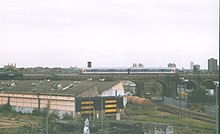Stewarts Lane

The depot in 1998. The steam shed was situated in front of the viaduct.
|
|
| Location | |
|---|---|
| Location | Battersea, United Kingdom |
| Coordinates | 51°28′21″N 0°08′38″W / 51.4725°N 0.1439°WCoordinates: 51°28′21″N 0°08′38″W / 51.4725°N 0.1439°W |
| OS grid | TQ289765 |
| Characteristics | |
| Owner(s) | DB Schenker |
| Depot code(s) | SL (1973-) |
| Type | Electric, EMU |
| History | |
| Opened | 1862 |
| Original | London Chatham and Dover Railway |
| Pre-grouping | Southern Railway |
| Post-grouping | Southern Railway |
| BR region | Southern Region |
| Former depot code(s) |
|
Stewarts Lane is a large railway servicing facility in Battersea in London, England, founded by the London Chatham and Dover Railway (LCDR) in 1862, to serve London Victoria railway station. It was sited in the midst of a maze of railway lines between 'Factory Junction' and 'Stewarts Lane Junction', adjacent to the site of the former Longhedge Railway Works. Prior to 1962 it was one of the largest motive power depots in the UK. Following the end of steam traction in the early 1960s it was converted into a Traction Maintenance Depot which is currently operated by DB Schenker.
In 1860 the London, Chatham and Dover Railway purchased 75 acres (300,000 m2) of land in Battersea, formerly part of the Long Hedge farm, to establish their locomotive works and the motive power depot, to provide motive power for services from the new London Victoria railway station (then under construction). The depot was originally known as ‘Longhedge’. In February 1862 a semi-roundhouse running shed was opened with space for 26 locomotives. The site was expanded in 1875/6 with 40 tracks around the central turntable, although only half were under cover.
The original depot was demolished in 1880/1 and replaced by a larger 16-road through shed on the same site, which was officially known as Stewarts Lane – but usually referred to as ‘Battersea’ or ‘Longhedge’ by the men. A coaling stage, turntable and wheel drop were provided. The depot was re-organised and a large mechanical coaling plant was added to enable the depot to deal with an increased locomotive allocation after 1932, following the closure of the nearby London Brighton and South Coast Railway Battersea shed. Stewarts Lane was provided with an asbestos roof in 1934 It suffered from bomb damage during the Second World War, some of which was never repaired. Otherwise it remained largely unchanged until closure to steam in 1963. Thereafter the tracks remained in use for stabling diesel locomotives, although much of the original building was destroyed by fire in 1967.
...
Wikipedia
